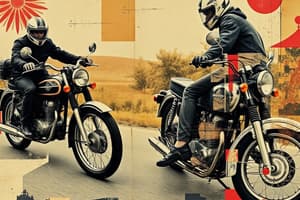Podcast
Questions and Answers
Give three reasons why motorcycling is more risky than driving a car.
Give three reasons why motorcycling is more risky than driving a car.
1.) Motorcycles lack cocoon roll cages, belts & air bags. 2.) Maneuvers that are routine in a car can be hazardous on a moto. 3.) Cars don't have to be balanced.
What is Rider Readiness?
What is Rider Readiness?
Being mentally prepared & attentive, physically rested & unimpaired, and having your motorcycle in good condition. Wearing appropriate gear and being aware & prepared for weather, roadway & traffic.
What does it mean to 'accept your responsibility'?
What does it mean to 'accept your responsibility'?
Ride within all the limits of your abilities & machine's capabilities.
What is the benefit of wearing apparel specifically designed for motorcycling?
What is the benefit of wearing apparel specifically designed for motorcycling?
What is the difference between retroflective and reflective?
What is the difference between retroflective and reflective?
Why aren't ordinary glasses or sunglasses sufficient eye protection?
Why aren't ordinary glasses or sunglasses sufficient eye protection?
What three things should you consider when shopping for your gear?
What three things should you consider when shopping for your gear?
Where do you find the recommended maintenance schedule for your motorcycle?
Where do you find the recommended maintenance schedule for your motorcycle?
What is ONE-C?
What is ONE-C?
How do you use the friction zone?
How do you use the friction zone?
Describe good riding posture.
Describe good riding posture.
What are the four steps to turning?
What are the four steps to turning?
Why is the 'aim' step so important?
Why is the 'aim' step so important?
What does lifting or pressing on the shift lever accomplish?
What does lifting or pressing on the shift lever accomplish?
Which brake provides more stopping power?
Which brake provides more stopping power?
How should you release the clutch when downshifting?
How should you release the clutch when downshifting?
How can you improve your visibility to other traffic?
How can you improve your visibility to other traffic?
What is the 20 second visual lead?
What is the 20 second visual lead?
What two words best describe scanning?
What two words best describe scanning?
What is the recommended minimum following distance?
What is the recommended minimum following distance?
What should you consider when choosing a lane position?
What should you consider when choosing a lane position?
How does SIPDE help make you an expert rider?
How does SIPDE help make you an expert rider?
Where do most multi-vehicle collisions occur?
Where do most multi-vehicle collisions occur?
What is a head check?
What is a head check?
What can you do to reduce reaction time in hazardous situations?
What can you do to reduce reaction time in hazardous situations?
How do you know if you are overriding your headlight?
How do you know if you are overriding your headlight?
Flashcards are hidden until you start studying
Study Notes
Motorcycle Risk Compared to Cars
- Motorcycles lack safety features like roll cages, seat belts, and airbags.
- Routine car maneuvers can be hazardous on motorcycles due to less stability.
- Cars are easier to handle since they do not require balancing.
Rider Readiness
- Involves mental preparedness and attentiveness.
- Requires physical rest and unimpaired condition.
- Motorcycle must be in good condition; appropriate gear is essential.
- Awareness of weather, roadway, and traffic conditions is crucial.
Accepting Responsibility
- Involves riding within personal ability and motorcycle capabilities.
Benefits of Motorcycle Apparel
- Designed gear offers protection, comfort, and improved control during rides.
Retroflective vs. Reflective
- Retroflective gear reflects light directly back to its source for enhanced visibility.
Eye Protection
- Ordinary glasses or sunglasses do not provide sufficient eye protection as they aren’t shatterproof.
Gear Considerations
- When shopping for riding gear, consider visibility, protection, and comfort.
Maintenance Schedule
- Recommended maintenance schedule is found in the Motorcycle Owner's Manual (MOM).
ONE-C Pre-Start Routine
- Stands for: On, Neutral, Engine Cut Off, Clutch/Choke.
Using the Friction Zone
- Involves easing out the clutch to get the motorcycle underway smoothly.
Good Riding Posture
- Maintain a straight back, head and eyes up, feet on footrests.
- Keep knees against the tank, relax arms, and slightly bend elbows.
Four Steps to Turning
- Key steps: Speed, Position, Aim, and Turn.
Importance of the "Aim" Step
- Essential for managing risks through curves once visualized.
Shifting Gears
- Accomplished by either lifting or pressing on the shift lever.
Stopping Power
- The front brake provides approximately 70% of stopping power.
Downshifting the Clutch
- Should be released gently for a smooth transition.
Improving Visibility
- Utilize headlights, signals, brake lights, and horn to enhance visibility to other traffic.
20 Second Visual Lead
- Recommended distance for scanning and managing risks while riding.
Scanning Techniques
- Scanning should be aggressive and purposeful to identify hazards.
Minimum Following Distance
- Recommended following distance is three seconds to maintain safety.
Lane Position Considerations
- When choosing a lane position, assess visibility, line of sight, space cushion, and escape routes.
SIPDE Process
- Stands for Scan, Identify, Predict, Decide, and Execute, which helps anticipate and act on hazards.
Collision Statistics
- Most multi-vehicle collisions take place at intersections.
Head Check Definition
- Refers to looking over the shoulder before changing lanes or turning.
Reducing Reaction Time
- Implement SIPDE to diminish reaction time in hazardous situations.
Overriding Headlight Awareness
- Occurs when the rider cannot see hazards beyond the range of the headlight.
Studying That Suits You
Use AI to generate personalized quizzes and flashcards to suit your learning preferences.




